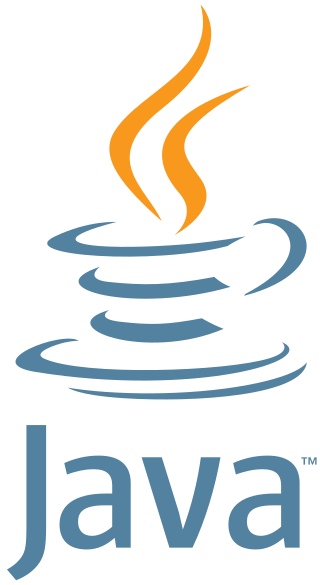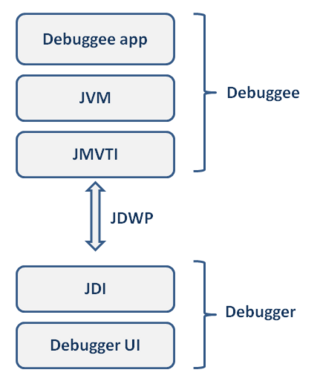Java is an island of Indonesia.

Java is a high-level, class-based, object-oriented programming language that is designed to have as few implementation dependencies as possible. It is a general-purpose programming language intended to let programmers write once, run anywhere (WORA), meaning that compiled Java code can run on all platforms that support Java without the need to recompile. Java applications are typically compiled to bytecode that can run on any Java virtual machine (JVM) regardless of the underlying computer architecture. The syntax of Java is similar to C and C++, but has fewer low-level facilities than either of them. The Java runtime provides dynamic capabilities that are typically not available in traditional compiled languages.

A Java virtual machine (JVM) is a virtual machine that enables a computer to run Java programs as well as programs written in other languages that are also compiled to Java bytecode. The JVM is detailed by a specification that formally describes what is required in a JVM implementation. Having a specification ensures interoperability of Java programs across different implementations so that program authors using the Java Development Kit (JDK) need not worry about idiosyncrasies of the underlying hardware platform.
Zing or ZING may refer to:
In software design, the Java Native Interface (JNI) is a foreign function interface programming framework that enables Java code running in a Java virtual machine (JVM) to call and be called by native applications and libraries written in other languages such as C, C++ and assembly.

The Java Platform Debugger Architecture (JPDA) is a collection of APIs to debug Java code.
Write once, run anywhere (WORA), or sometimes Write once, run everywhere (WORE), was a 1995 slogan created by Sun Microsystems to illustrate the cross-platform benefits of the Java language. Ideally, this meant that a Java program could be developed on any device, compiled into standard bytecode, and be expected to run on any device equipped with a Java virtual machine (JVM). The installation of a JVM or Java interpreter on chips, devices, or software packages became an industry standard practice.
HotSpot, released as Java HotSpot Performance Engine, is a Java virtual machine for desktop and server computers, developed by Sun Microsystems which was purchased by and became a division of Oracle Corporation in 2010. Its features improved performance via methods such as just-in-time compilation and adaptive optimization. It is the de facto Java Virtual Machine, serving as the reference implementation of the Java programming language.
Jikes Research Virtual Machine is a mature virtual machine that runs programs written for the Java platform. Unlike most other Java virtual machines (JVMs), it is written in the programming language Java, in a style of implementation termed meta-circular. It is free and open source software released under an Eclipse Public License.
Jazelle DBX is an extension that allows some ARM processors to execute Java bytecode in hardware as a third execution state alongside the existing ARM and Thumb modes. Jazelle functionality was specified in the ARMv5TEJ architecture and the first processor with Jazelle technology was the ARM926EJ-S. Jazelle is denoted by a "J" appended to the CPU name, except for post-v5 cores where it is required for architecture conformance.
SafeTSA is a static single assignment form (SSA) intermediate representation capable of representing all of the type safety of the Java programming language and the standard Java Virtual Machine (JVM) byte-code.
Java Optimized Processor (JOP) is a Java processor, an implementation of Java virtual machine (JVM) in hardware.
Application virtualization software refers to both application virtual machines and software responsible for implementing them. Application virtual machines are typically used to allow application bytecode to run portably on many different computer architectures and operating systems. The application is usually run on the computer using an interpreter or just-in-time compilation (JIT). There are often several implementations of a given virtual machine, each covering a different set of functions.

Java is a set of computer software and specifications that provides a software platform for developing application software and deploying it in a cross-platform computing environment. Java is used in a wide variety of computing platforms from embedded devices and mobile phones to enterprise servers and supercomputers. Java applets, which are less common than standalone Java applications, were commonly run in secure, sandboxed environments to provide many features of native applications through being embedded in HTML pages.

Squawk is a Java micro edition virtual machine for embedded system and small devices. Most virtual machines for the Java platform are written in low level native languages such as C/C++ and assembler; what makes Squawk different is that Squawk's core is mostly written in Java. A Java implementation provides ease of portability, and integration of virtual machine and application resources such as objects, threads, and operating-system interfaces.
In software development, the programming language Java was historically considered slower than the fastest third-generation typed languages such as C and C++. In contrast to those languages, Java compiles by default to a Java Virtual Machine (JVM) with operations distinct from those of the actual computer hardware. Early JVM implementations were interpreters; they simulated the virtual operations one-by-one rather than translating them into machine code for direct hardware execution.
Eclipse OpenJ9 is a high performance, scalable, Java virtual machine (JVM) implementation that is fully compliant with the Java Virtual Machine Specification.

The Da Vinci Machine, also called the Multi Language Virtual Machine, was a Sun Microsystems project aiming to prototype the extension of the Java Virtual Machine (JVM) to add support for dynamic languages.
Java bytecode is the instruction set of the Java virtual machine (JVM), the language to which Java and other JVM-compatible source code is compiled. Each instruction is represented by a single byte, hence the name bytecode, making it a compact form of data.
This page is based on this
Wikipedia article Text is available under the
CC BY-SA 4.0 license; additional terms may apply.
Images, videos and audio are available under their respective licenses.





